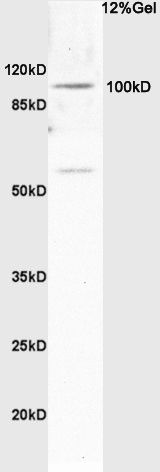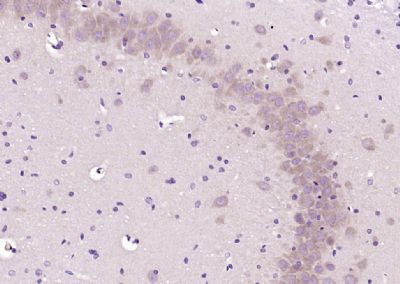产品中心
当前位置:首页>产品中心Anti-Synphilin-1
货号: bs-1905R 基本售价: 1380.0 元 规格: 100ul
- 规格:100ul
- 价格:1380.00元
- 规格:200ul
- 价格:2200.00元
产品信息
- 产品编号
- bs-1905R
- 英文名称
- Synphilin-1
- 中文名称
- 核突触蛋白相互作用蛋白1抗体
- 别 名
- Synphilin-1; Synphilin1; Synphilin 1; Alpha-synuclein-interacting protein; Sncaip; Syph1, Syph 1,Syph-1; Alpha synuclein interacting protein; MGC39814; SNCAIP; SNCAP_HUMAN; Sph1; Synuclein alpha interacting protein (synphilin); SYPH 1.
- 规格价格
- 100ul/1380元购买 200ul/2200元购买 大包装/询价
- 说 明 书
- 100ul 200ul
- 研究领域
- 细胞生物 免疫学 神经生物学
- 抗体来源
- Rabbit
- 克隆类型
- Polyclonal
- 交叉反应
- Human, Mouse, Rat, Chicken, Dog, Pig, Cow, Horse, Rabbit, Sheep, Guinea Pig,
- 产品应用
- WB=1:500-2000 ELISA=1:500-1000 IHC-P=1:400-800 IHC-F=1:400-800 IF=1:100-500 (石蜡切片需做抗原修复)
not yet tested in other applications.
optimal dilutions/concentrations should be determined by the end user.
- 分 子 量
- 100kDa
- 细胞定位
- 细胞浆
- 性 状
- Lyophilized or Liquid
- 浓 度
- 1mg/ml
- 免 疫 原
- KLH conjugated synthetic peptide derived from human Synphilin-1:51-150/919
- 亚 型
- IgG
- 纯化方法
- affinity purified by Protein A
- 储 存 液
- 0.01M TBS(pH7.4) with 1% BSA, 0.03% Proclin300 and 50% Glycerol.
- 保存条件
- Store at -20 °C for one year. Avoid repeated freeze/thaw cycles. The lyophilized antibody is stable at room temperature for at least one month and for greater than a year when kept at -20°C. When reconstituted in sterile pH 7.4 0.01M PBS or diluent of antibody the antibody is stable for at least two weeks at 2-4 °C.
- PubMed
- PubMed
- 产品介绍
- background:
This gene encodes a protein containing several protein-protein interaction domains, including ankyrin-like repeats, a coiled-coil domain, and an ATP/GTP-binding motif. The encoded protein interacts with alpha-synuclein in neuronal tissue and may play a role in the formation of cytoplasmic inclusions and neurodegeneration. A mutation in this gene has been associated with Parkinsons disease. Alternatively spliced transcript variants encoding different isoforms of this gene have been described, but the full-length nature of only two have been determined. [provided by RefSeq, Jul 2011].
Function:
Isoform 2 inhibits the ubiquitin ligase activity of SIAH1 and inhibits proteasomal degradation of target proteins. Isoform 2 inhibits autoubiquitination and proteasomal degradation of SIAH1, and thereby increases cellular levels of SIAH. Isoform 2 modulates SNCA monoubiquitination by SIAH1.
Subunit:
Homodimer (Probable). Heterodimer of isoform 1 and isoform 2 (Probable). Interacts with SIAH1, SIAH2, SNCA, RNF19A AND PARK2. Isoform 2 has a strong tendency to form aggregates and can sequester isoform 1.
Subcellular Location:
Cytoplasm. Detected in cytoplasmic inclusion bodies, together with SNCA.
Tissue Specificity:
Detected in brain (at protein level). Widely expressed, with highest levels in brain, heart and placenta.
Post-translational modifications:
Ubiquitinated; mediated by SIAH1, SIAH2 or RNF19A and leading to its subsequent proteasomal degradation. In the absence of proteasomal degradation, ubiquitinated SNCAIP accumulates in cytoplasmic inclusion bodies. Isoform 2 is subject to limited ubiquitination that does not lead to proteasomal degradation.
DISEASE:
Parkinson disease (PARK) [MIM:168600]: A complex neurodegenerative disorder characterized by bradykinesia, resting tremor, muscular rigidity and postural instability. Additional features are characteristic postural abnormalities, dysautonomia, dystonic cramps, and dementia. The pathology of Parkinson disease involves the loss of dopaminergic neurons in the substantia nigra and the presence of Lewy bodies (intraneuronal accumulations of aggregated proteins), in surviving neurons in various areas of the brain. The disease is progressive and usually manifests after the age of 50 years, although early-onset cases (before 50 years) are known. The majority of the cases are sporadic suggesting a multifactorial etiology based on environmental and genetic factors. However, some patients present with a positive family history for the disease. Familial forms of the disease usually begin at earlier ages and are associated with atypical clinical features. Note=Disease susceptibility may be associated with variations affecting the gene represented in this entry.
Similarity:
Contains 6 ANK repeats.
SWISS:
Q9Y6H5
Gene ID:
9627
Database links:Entrez Gene: 9627Human
Entrez Gene: 67847Mouse
Entrez Gene: 307309Rat
Omim: 603779Human
SwissProt: Q9Y6H5Human
SwissProt: Q99ME3Mouse
Unigene: 426463Human
Unigene: 292168Mouse
Important Note:
This product as supplied is intended for research use only, not for use in human, therapeutic or diagnostic applications.
- 产品图片
 Protein: brain(rat) lysates at 30ug;
Protein: brain(rat) lysates at 30ug;
Primary: Anti-Synphilin-1 (bs-1905R) at 1:200;
Secondary: HRP conjugated Goat Anti-Rabbit IgG(bs-0295G-HRP) at 1: 3000;
ECL excitated the fluorescence;
Predicted band size : 100kD
Observed band size : 100kD Tissue/cell: rat brain tissue; 4% Paraformaldehyde-fixed and paraffin-embedded;
Tissue/cell: rat brain tissue; 4% Paraformaldehyde-fixed and paraffin-embedded;
Antigen retrieval: citrate buffer ( 0.01M, pH 6.0 ), Boiling bathing for 15min; Block endogenous peroxidase by 3% Hydrogen peroxide for 30min; Blocking buffer (normal goat serum,C-0005) at 37℃ for 20 min;
Incubation: Anti-Synphilin-1 Polyclonal Antibody, Unconjugated(bs-1905R) 1:200, overnight at 4°C, followed by conjugation to the secondary antibody(SP-0023) and DAB(C-0010) staining

